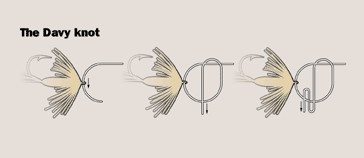Ken B reports: Thank you for the insight on the Davy knot. I first learned the knot three years ago from John Wilson in Arkansas. I was elated about the knot until my guiding season began on the South Fork of the Snake. I charmed many clients with the speed of tying the knot. They were not as charmed when the knot failed with small dries in riffled. I have discovered the Pitzen or Sixteen twenty knot far superior. I have bench tested both end to end with the same piece of mono to identical hooks. The Pitzen wins 100% of the time.
By Geoff Samples

Most fly fishers spend an entire lifetime using one or two knots for their fishing. It’s common for fishers to use a clinch knot, improved clinch, turle or Trilene knot to attach a fly to leader. Once you have a favorite knot, it’s difficult to switch to another. I switched fly fishing knots a year ago and will not return to the old, traditional ones. When I was selected for Team USA for the World Youth Flyfishing Championships, I determined to perfect my game and become the best fly fisher possible. Adding the new knot to my arsenal was, I believe, one of the reasons I finished 16th out of 75 competitors.
Preparing for the World Youth Flyfishing Championships meant you had to be able to re-tie your whole cast of three flies in about five minutes. We had to learn fast methods because lost time meant lost fish. One of our team coaches, Davy Wotton, competed for many years for the Welsh national team and in individual professional events. Through trial and error, he invented a knot that allowed him to attach a fly in seconds. He appropriately dubbed it "the Davy knot." This knot is so easy and simple to tie, it sometimes seems difficult! I made my Dad sit down and practice tying it for an hour as he watched TV. It became easy for him and he tossed out his clinch knot with his antiquated fiberglass rod. Once you use this knot, you will not use another one!
The Davy knot is fast and strong. Unlike other knots that are used to attach flies, the tippet is not pulled down on the knot to burn and weaken the mono. I have used this knot in competition without a single failure, and in 12 months I’ve had only one knot break in hundreds of hours of use. As a guide, I have taught the Davy knot to clients with enthusiastic response. When I have demonstrated the knot at fly fishing shows and at the High Country Fly Fishers club, the audiences have drooled with delight.
Follow these instructions to tie the knot:
1. Take your fly and pass your tippet through the bottom of the eyelet. Turn the fly upside down so the hook point is turned up or on the top.
2. With the fly extended to the left, pull or extend about three or four inches of tippet through the eye.
3. Take your tag piece of mono and pass over the top of the main leader (away from you) and draw it back through, making a loop.
4. Take the tippet and pass it under, then over the top of the bottom leg of the loop. If you have been successful, the tag end will point directly toward you.
5. To secure the knot, bite the tag piece and pull the leader end taut, causing the knot to close. If you have tied the Davy knot properly, the knot is firmly fastened and will not slip.
Factors about knots
Davy Wotten said the knot was tested and shows nearly 100 percent break strength. A 100 percent knot is not as critical to fishing as you might believe. Wind knots, nicks, casting, and the force of playing fish (hopefully!), can weaken all knots, leaders and tippets. Knots and leaders rarely remain at 100 percent for very long. The big advantage of the Davy knot is that you can re-tie it quickly to keep your system in best form.
I also like the Davy knot because it is so much smaller than others and does not impede the action of the fly as much. It is extremely effective with regular sized flies. With 7X and smaller tippet, care must be taken to tie the knot exactly and not weaken the tippet material with excess pulling.
My addition to the Davy knot could be called the Geoff version. I can tie the knot so precisely that when I measure and secure the tag material, I don’t leave any excess tip. There is no material to clip, thus I save the step of using clippers. I also waste zero tippet material. This is an advanced technique and requires feeding the excess tippet back through the knot being formed as you bite the tag. Be sure you stay away from the hook point!
I use the Davy knot for all styles of fly fishing and not just dabbing. I am totally convinced that this is the best knot available for securing a fly to leader.
Try out the Davy knot. Practice it at home in front of the TV with 4X tippet material and a size 12 fly. In an hour, you’ll tie a few dozen knots. It’ll become second nature for you. Once you’ve used the Davy knot, you’ll never settle for anything less!
Copyright Geoff Samples, 2006

